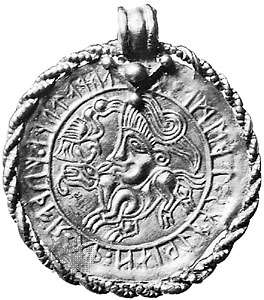Your Cart is Empty
Menu
-
- Shop by Type
- End of Line Sale Items
- New In
- Viking Gifts Under $30
- Hand Forged Axes
- Silver Viking Jewelry
- Stainless Steel Jewelry
- Cremation Jewelry
- Necklaces and Pendants
- Hand Carved Wooden Pendants
- Kings Chains
- Viking Drinking Horns
- Pendant Chains
- Rings
- Bracelets
- Earrings
- Beard Beads and Beard Rings
- Collectables
- Ceramic Mugs
- Street Wear
- Horn Jewelry
- Bronze and Pewter Jewelry
- Shop by Theme
- Viking Axe
- Celtic Jewelry
- Dragon or Serpent
- Viking Raven
- Wolf / Fenrir
- Rune Jewelry
- Odin Jewelry
- Ram / Goat
- Shieldmaidens / Lagertha
- Sword, Spear or Arrow
- Thor's Hammer / Mjolnir
- Tree of Life / Yggdrasil
- Helm of Awe / Aegishjalmur
- Triquetra or Triskelion
- Valknut / Knot of Slain
- Vegvisir / Viking Compass
- Veles / Bear
- Blogs
- Help
-
- Login

The Vadstena Bracteate

The Vadstena Bracteate is so called because it was discovered in Vadstena, Sweden in 1774 and is formed of a thin sheet of round gold (bracteate in Latin means a thin piece of metal). The treasure was found alongside a ring and a piece of gold sheet and was nearly melted down by a local goldsmith.

The bracteate was believed to have been made in about AD 500 by first carving the design in relief on some resistant material, such as bronze or wood, and then pressing a thin sheet of gold over the carving.
The Vadstena bracteate features a four legged animal topped by a man's head. In front of the man is a bird thought to be a raven. Because of the raven association it has been assumed that the man is representative of the Norse god Odin.
Around Odin is a 24 character Futhark (runic alphabet) arranged in three groups of eight symbols separated by dots, followed by eight characters, tuwa tuwa, of unknown and perhaps magical, significance.
At the top of the bracteate is a bail (a loop to enable it to be hung on a chain) indicating that it must have been worn as an amulet probably designed to protect the wearer (interestingly the last rune is hidden by the bail suggesting that it was converted to an amulet after it was first made).
The Vadstena Bracteate was stolen in 1938 from the Swedish Museum of National Antiquities and has never been found.
